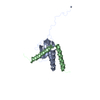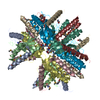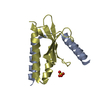+Search query
-Structure paper
| Title | A unique hetero-hexadecameric architecture displayed by the Escherichia coli O157 PaaA2-ParE2 antitoxin-toxin complex. |
|---|---|
| Journal, issue, pages | J Mol Biol, Vol. 428, Issue 8, Page 1589-1603, Year 2016 |
| Publish date | Apr 24, 2016 |
 Authors Authors | Yann G-J Sterckx / Thomas Jové / Alexander V Shkumatov / Abel Garcia-Pino / Lieselotte Geerts / Maia De Kerpel / Jurij Lah / Henri De Greve / Laurence Van Melderen / Remy Loris /   |
| PubMed Abstract | Many bacterial pathogens modulate their metabolic activity, virulence and pathogenicity through so-called "toxin-antitoxin" (TA) modules. The genome of the human pathogen Escherichia coli O157 ...Many bacterial pathogens modulate their metabolic activity, virulence and pathogenicity through so-called "toxin-antitoxin" (TA) modules. The genome of the human pathogen Escherichia coli O157 contains two three-component TA modules related to the known parDE module. Here, we show that the toxin EcParE2 maps in a branch of the RelE/ParE toxin superfamily that is distinct from the branches that contain verified gyrase and ribosome inhibitors. The structure of EcParE2 closely resembles that of Caulobacter crescentus ParE but shows a distinct pattern of conserved surface residues, in agreement with its apparent inability to interact with GyrA. The antitoxin EcPaaA2 is characterized by two α-helices (H1 and H2) that serve as molecular recognition elements to wrap itself around EcParE2. Both EcPaaA2 H1 and H2 are required to sustain a high-affinity interaction with EcParE2 and for the inhibition of EcParE2-mediated killing in vivo. Furthermore, evidence demonstrates that EcPaaA2 H2, but not H1, determines specificity for EcParE2. The initially formed EcPaaA2-EcParE2 heterodimer then assembles into a hetero-hexadecamer, which is stable in solution and is formed in a highly cooperative manner. Together these findings provide novel data on quaternary structure, TA interactions and activity of a hitherto poorly characterized family of TA modules. |
 External links External links |  J Mol Biol / J Mol Biol /  PubMed:26996937 PubMed:26996937 |
| Methods | SAS (X-ray synchrotron) / X-ray diffraction |
| Resolution | 2.671 - 3.82 Å |
| Structure data |  SASDAA9:  SASDAB9:  SASDC84:  PDB-5cw7:  PDB-5cze:  PDB-5czf: |
| Chemicals |  ChemComp-GOL:  ChemComp-HOH:  ChemComp-SO4: |
| Source |
|
 Keywords Keywords | TOXIN / toxin-antitoxin |
 Movie
Movie Controller
Controller Structure viewers
Structure viewers About Yorodumi Papers
About Yorodumi Papers




